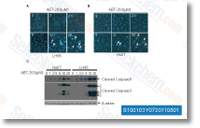Our findings give the initial large scale miRNA dis covery in sugarcane and aid to clarify about likely miRNA roles in regulatory pathways of this and other crops. Strategies Plant material and experimental procedure Water deficit assay Stalks of sugarcane cultivars, with unique drought sensitivities, have been presented through the Centro de Tecnolo gia Canavieira, Dependant on chlorophyll and water information measurements, cultivars CTC15, CTC6, SP83 2847 and SP83 5073 and CTC9, CTC13, SP90 1638 and SP90 3414 are regarded as drought tolerant and delicate, respectively. Stalks were germinated and grown in five L pots within a greenhouse at 28 C. Just after 3 months, the plants have been exposed to drought strain by withholding watering. Treated and handle roots had been harvested at 0 and 24 hours of treatment method, respectively.
4 little RNA libraries for deep se quencing have been constructed from RNA pools of sensi selleck tive and tolerant sugarcane cultivars submitted to drought worry and control plants. Salt tension assay In vitro grown sugarcane plantlets have been rooted in Murashige and Skoog media supplemented with sucrose, selleck inhibitor citric acid, kinetin, and IBA, Plants have been maintained at 110 mE m two s luminosity, 12 h photoperiod, at 28 C. After the improvement of a root procedure plantlets had been transferred to hydroponic procedure compound in plastic containers supplemented with Hoagland resolution, Plantlets have been acclimated dur ing two weeks in a greenhouse at 28 C after which NaCl 170 mM alternative was extra. Control plants were major tained in distillated water. Leaves of taken care of and manage plantlets were harvested at 0, 1, 6 and 24 hrs after treat ment.
A set of five plants was collected for each time level with the experiment, as well as the pooled material was used in the building of 4 modest RNA libraries. Pathogen infection assay Acidovorax avenae subsp avenae  obtained in the Cul ture Collection from the Instituto Biol?gico was grown in NA medium at 28 C. In vitro develop sugarcane plantlets were cultivated as described within the saline strain experiment. Just after the development of the root procedure, vigorous and pathogen no cost plants were divided in two halves having a scalpel. 1 half was inoculated immersing the root sys tem for 5 minute within a suspension of the. avenae in distilled water then washed twice with dis tilled water as a way to eliminate superficial bacteria. The other half was utilised as control, immersing the root method in distilled water for 5 minutes and after that washed twice with distilled water. Inoculated and control plants were transferred to MS media and stored for 7 days. Following this period, total plants were harvested and examined for bacterial colonization by plate counting, and modest RNA libraries of control and inoculated plants have been constructed.
obtained in the Cul ture Collection from the Instituto Biol?gico was grown in NA medium at 28 C. In vitro develop sugarcane plantlets were cultivated as described within the saline strain experiment. Just after the development of the root procedure, vigorous and pathogen no cost plants were divided in two halves having a scalpel. 1 half was inoculated immersing the root sys tem for 5 minute within a suspension of the. avenae in distilled water then washed twice with dis tilled water as a way to eliminate superficial bacteria. The other half was utilised as control, immersing the root method in distilled water for 5 minutes and after that washed twice with distilled water. Inoculated and control plants were transferred to MS media and stored for 7 days. Following this period, total plants were harvested and examined for bacterial colonization by plate counting, and modest RNA libraries of control and inoculated plants have been constructed.
Deubiquitinase
Mechanism, specificity and structure of the deubiquitinases
